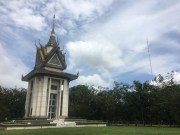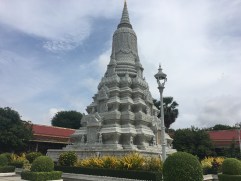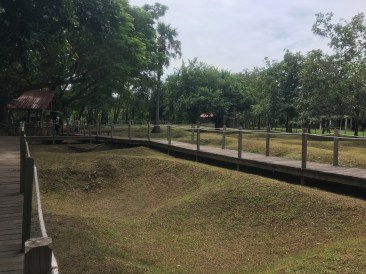The killing fields were not included in our itinerary. I can understand why. A harrowing experience which no one wants to go through and yet you cannot come to Phnom Penh and not visit the site. The guide said he will take us if most agree and most did on the second count when those who were reluctant initially realised how much some of us wanted to go there. Was it because of some morbid fascination, I wondered. After the Hiroshima experience, I am not sure how I will feel about the visit, but we need to go there to pay our respects to the victims.
Our first stop is the King’s palace. As we walk through the gates the staff are relaxing and sitting around on benches. It is still early. Once again the full splendour is only visible when we walk around the corner into the gardens and the buildings come into view. There are many buildings in this complex. The most imposing one in front of us is the Throne Hall. Towards our right hand side the Moonlight Hall has a balcony which opens on to the boulevard from where the King addresses his subjects on important occasions. This is the part that is visible from the main road which runs next to the area where the rivers Tonle Sap, Bassac and Mekong confluence. The royal residence is behind the Throne Hall and the flag is at full mast meaning that King Sihamoni is in residence. The buildings were built in the Khmer style with gilded roofing during the second half of the nineteenth century. Only the throne hall is open, but we are not allowed to go in or take photos. The majestic throne sits in prime position waiting for the next coronation. Everything inside glitters and is covered in gold paint. The manicured gardens add to the splendour.
From here we walk to the south part of the complex, where the ‘Silver Pagoda’ is situated. Thus named because of the flooring. Silver tiles weighing over a kilogram each cover the entire floor. Most of it is covered with carpet, but the tiles are visible in places. The pagoda houses a thousand Buddhas in various shapes and sizes. The most prominent ones are the diamond encrusted gold Buddha and the emerald Buddha. Surrounding the pagoda are three Stupas. One has the ashes of the late King and his four year old daughter who died during the civil war. She died from dengue fever and as all the good doctors in the city were slaughtered at that time she also ended up being a victim of the Pol Pot regime from lack of medical attention. One stupa contains ashes of his parents and the third is for his son, the present king. A statue of the king on a horse can be seen adjacent to the pagoda. It used to be the statue of Napoleon, but after independence the head was swapped for a bust of the King. There is also a model of the Angkor Wat behind the pagoda. It gives a much more better idea of the layout of the temple complex compared to the model at the King’s palace in Bangkok. The surrounding walls have a covered walkway and are painted with murals. As we walk out to the exit, musicians are playing traditional instruments.
We drive down country roads to Choeung Ek, the place where prisoners from S21 were taken for their final journey. There are 343 such sites dotted around Cambodia. Of this 129 have been found and 86 excavated. The first monument that we see from afar is the memorial stupa which was built to house the skeletons which were unearthed. It was inaugurated in 1988. Prior to that the bones were stored in a smaller building on the site.









The guide takes us around the walkway built around the mounds of earth between which graves were dug mostly by the prisoners, who were then beaten to death with the same implements they used to dig the holes. A loud speaker was tied to the tree in front of us which played music to confuse the victims and drown their cries. Each time it rains, bones and pieces of rags surface and we can see rags which were worn by the prisoners lying around caked in mud. History that we can just bend down and touch. Towards the end of the regime almost 300 people were brought here every night and if they couldn’t kill them all they were put in a dark room to await their execution the next day.
The most harrowing part of the walk was the site where women and children were killed. The tree that took the impact and ended up being a silent witness to one of the most heinous crimes in society stands here bearing the scars. The site is marked by short bamboo walls and corrugated tin covering. The place is decorated with blessed red strings left by monks and beaded and coloured bangles for the dead spirits. Most of us struggled to stifle a silent sob at this point.
The largest grave had 450 victims skeletal remains. Another had a hundred beheaded bodies. These graves are also marked by bamboo walls and covered. We went in to watch a short film that was filmed when the area was discovered. It showed the mounds covered in skulls and bones. There was an eye witness account by those who discovered the place in the film clip.
We just have enough time to go in and see the Memorial Stupa at close quarters. Skulls separated according to age groups, bones, teeth and clothes are kept in different sections and levels. Flowers are laid every day and incense sticks burnt by the tourists and locals.
It has been a disturbing afternoon. An afternoon that I will not forget, but I had to do it. The tens of thousands who died here and the millions around the various killing fields in Cambodia need to be remembered. I would like to say that lessons need to be learnt so that history will not repeat itself but looking around the world one knows that we have a long way to go to achieve this reality. Let’s hope that the victims here did not die in vain and that the lessons that history provide will act as a deterrent in the future.

